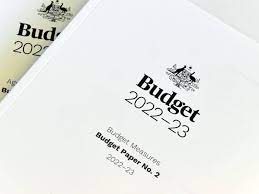
The Federal Treasurer, Mr Josh Frydenberg, handed down the 2022–23 Federal Budget at 7:30 pm (AEST) on 29 May 2022.
Since MYEFO, the estimated underlying cash balance has improved by a substantial $103.6 billion over the 5 years to 2025‑26. This Budget projects a halving in the deficit to 1.6 per cent of GDP by 2025‑26 before falling to 0.7 per cent of GDP by the end of the medium term. This improvement will flow through to lower debt.
Below is a summary of some of the key measures, the full Budget papers are available at www.budget.gov.au
Cost of living & taxation
- From 1 July this year, over 10 million individuals will receive a one-off $420 cost of living tax offset. Combined with the low and middle income tax offset (LMITO), eligible low- and middle-income earners will receive up to $1,500 for a single income household, or up to $3,000 for a dual income household.
- To help Australians meet cost of living pressures, the Government is providing a one‑off, income tax-exempt payment of $250.
- The Government will reduce fuel excise by 50 per cent for 6 months. This will see excise on petrol and diesel cut from 44.2 cents per litre to 22.1 cents per litre.
- The Government continues to support child care services facing challenging circumstances, including COVID-19 and recent floods. This includes $279 million in COVID‑19 support, $6.9 million in business continuity payments and support for services through Special Circumstances grants in the Community Child Care Fund.
- The new cost of living offset, together with the low and middle income tax offset (LMITO) for 2021‑22, will provide around $12 billion in support when taxpayers lodge their tax returns from 1 July 2022.
- A one-off $250 payment for eligible pensioners will be made by the Government to help pay for things like groceries, housing and petrol.
Small Business
- The Government will deliver more than $21 billion in tax cuts to small businesses from 2015‑16 to 2024‑25, with around $2.6 billion flowing in 2022‑23. This includes reducing the company tax rate for small businesses from 30 per cent in 2013-14 to 25 per cent from 1 July 2021, the lowest level in 50 years.
- The Government is providing $1.0 billion for a new Technology Investment Boost to encourage small businesses to go digital. Small businesses with annual turnover less than $50 million will be able to deduct a bonus 20 per cent of the cost of expenses and depreciating assets that support digital uptake. This includes portable payment devices, cyber security systems or subscriptions to cloud-based services. The boost will apply to eligible expenditure of up to $100,000 per year, incurred from Budget night until 30 June 2023.
- Small businesses will also have access to a new 20 per cent bonus deduction for eligible external training courses for up skilling employees. The Skills and Training Boost will apply to expenditure incurred from Budget night until 30 June 2024, providing $550 million in tax relief.
- A $5.6 million investment into a dedicated small business unit in the Fair Work Commission to provide additional support.
Home Owners
- Under the Home Guarantee Scheme, part of an eligible home buyer’s home loan will be guaranteed, enabling Australians to enter the property market sooner with a smaller deposit.
- From 1 July 2022, the maximum amount of voluntary contributions that can be released under the FHSSS will be increased from $30,000 to $50,000 enabling first home owners to achieve their dreams of home ownership sooner.
Superannuation
- The temporary reduction to the minimum income drawdown requirement for superannuation pensions will be further extended until 30 June 2023.This will allow people to minimise the need to sell down assets given ongoing market volatility. It applies to account-based, transition to retirement and term allocated superannuation pensions.
The Budget deficit for 2022-2023 is $78 billion (or 3.4 per cent of GDP), Australia’s gross debt is $977 billion (tipped to hit $1 trillion next year) and net debt is sitting at $714.9 billion (or 31.1 per cent of GDP).
If you would like to discuss how these changes may affect you and your financial situation please get in touch with your advisor today.
